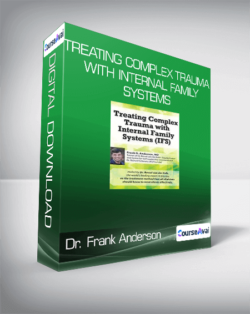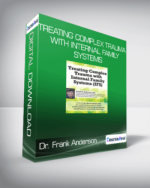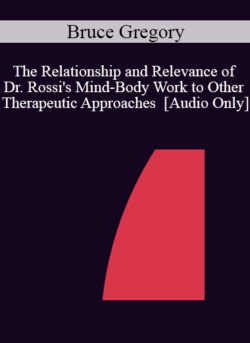Most modes of psychotherapy believe to have “parts” is pathological. NOT in Internal Family Systems (IFS). In IFS, the idea of multiplicity of the mind is normal. Every part has a good intention, and every part has value. Even for trauma survivors.Purchase Dr. Frank Anderson – Treating Complex Trauma with Internal Family Systems courses at here with PRICE $299 $111Dr. Frank Anderson – Treating Complex Trauma with Internal Family SystemsMost modes of psychotherapy believe to have “parts” is pathological. NOT in Internal Family Systems (IFS). In IFS, the idea of multiplicity of the mind is normal. Every part has a good intention, and every part has value. Even for trauma survivors.In the treatment of trauma, IFS is different from traditional phase-oriented treatments. Instead of starting with building resources in clients before processing traumatic memories, it welcomes extreme symptoms from the onset, learns about their positive protective intentions and gets their permission to access the traumatic wounds. IFS also differs from traditional attachment focused therapies, both value the therapeutic relationship; however, IFS additionally supports the relationship between the client’s “Self” and their part as the primary healing agent.Hailed by Dr. van der Kolk, the world’s leading expert in trauma, IFS is the treatment method that all clinicians should know. Nearly all clients with a trauma history have innate abilities that help them improve their mental health if they listen to their parts. IFS does just that. IFS is an evidence-based approach for clinicians working with traumatized clients. Once you see it in action, you’ll want to incorporate it into your practice.Watch IFS and trauma expert Frank Anderson, MD, colleague of Dr. Bessel van der Kolk and Dr. Richard Schwartz, in this transformational certificate training.Clients will leave your office with skills to use outside the therapy room to help them master their emotions. This experiential training will show video demonstrations and include exercises and meditation techniques to use with your clients.Integrate the IFS model into your clinical practice and accelerate the healing from complex trauma.Identify, specify and clarify the protective parts of clients with trauma histories to help with assessment and treatment planning.Offer an alternative view of symptoms and psychopathology, showing how client’s parts are actually trying to protect them from emotional pain and psychological pain.Demonstrate how IFS translates common comorbidities into parts language, showing a non-pathological perspective of mental health disorders.Communicate how IFS increases the therapist’s curious and compassionate self when working with clients who have trauma histories.Differentiate a therapeutic issue from a biological condition for better decision making in your clinical practice.Compare traditional attachment theory perspectives on healing to the IFS view (an internal attachment model) and learn to trust the clients’ internal relationship to heal their traumatic wounds.Understand how to respond to the extreme symptoms of trauma by determining if they are rooted in sympathetic activation or parasympathetic withdrawal.Demonstrate IFS specific therapeutic techniques that shift arousal and withdrawal, allowing quicker access to clients’ traumatic vulnerabilities.Develop a deep understanding of how neuroscience informs therapeutic decisions in IFS therapy.Integrate IFS with your current treatment approaches including EMDR, DBT, and Sensorimotor Psychotherapy.Compare IFS to traditional phase-oriented treatment and learn accelerated ways of accessing and healing traumatic wounds.Get Dr. Frank Anderson – Treating Complex Trauma with Internal Family Systems downloadTreating the Various Types of TraumaAcute traumaPTSDComplex or relational traumaDevelopmental and attachment traumasExtreme or dissociative traumaInternal Family Systems (IFS): Healing of Emotional WoundsThe origins, goals & assumptionsA non-pathologizing, accelerated approach, rooted in neuroscienceDifferent from phase-oriented treatmentThe importance of our protective responsesDeal with emotional overwhelm head-onMultiplicity of the mind – we all have partsHealing at the cellular levelStudy limitations: small sample size, no control groupClinical considerations for clients experiencing abuseManage Common Co-MorbiditiesDepression, panic attacks, substance abuse, eating disorders, ADD and OCDA non-pathological approachComorbidities as protective responses to traumaSymptoms as “parts of the self”Differentiate Therapeutic Issues from Biological ConditionsIntersection of biology and situation (“Real Mind-Body Medicine”)Therapist’s role in biology – When to refer and when to work it throughPsychotherapy of psychopharmacologyThe IFS TechniqueStep 1: Identify the Target SymptomIdentify the “target symptom”Apply meditation practicesSeparate the person (self) from the symptomLearn about its intentionStep 2: Gain Access to Internal Strengths & Resource for HealingMove from defensiveness to curiosityThe “Self” of the therapist-countertransference redefinedAccess compassion to open the pathways toward healingRole of empathy in healing – the benefits and the downsidesStep 3: Find the Fear and Function of the SymptomFocusing on its fearThe real story behind the symptomFoster the internal relationshipAttachment Disorders and Relational TraumaIFS as internal attachment workAttachment styles as parts of selfAttachment trauma – the role of the therapistHeal relational wounds of childhoodClient’s “Self” as the corrective objectWork with preverbal traumaThe Neurobiology of TraumaNeuroscience for therapists – what you need to knowFear circuitry and the development of PTSDExtreme reactions and Autonomic Nervous SystemRage to suicide and dissociation to shameDealing with the Extreme Reactions of TraumaTalk directly to the symptom-direct accessIntroducing the part to the “Self”Deal with the overwhelm – no need for building resourcesTherapist parts – How to stay clear and calm while working with clients in extreme statesHow Neuroscience Informs Therapeutic DecisionsTop-down and bottom-up strategies rooted in neuroscienceWhen it’s necessary to take over and “be the auxiliary brain” for your clientSensing vs. making sense of thingsAt home strategiesStep 4: Healing of Traumatic Wounds:Three phases to healing:Witness the painRemove the wounded part out of the pastLet go of the feelings, thoughts and beliefsScience behind the healing – memory reconsolidationIntegrate IFS into Your Treatment ApproachEMDR, DBT, Sensorimotor/SE and other methodsTransformation vs adaptation or rehabilitationGoing beyond the cognitive (experiential therapies)Integrate IFS with your current clinical approachGet Dr. Frank Anderson – Treating Complex Trauma with Internal Family Systems downloadPurchase Dr. Frank Anderson – Treating Complex Trauma with Internal Family Systems courses at here with PRICE $299 $111
 Supercharge Your Sex LIfe – Jordan Gray GB
Supercharge Your Sex LIfe – Jordan Gray GB
 Mindvalley, Marie Diamond – Feng Shui for Life 2019
₹16,600.00
Mindvalley, Marie Diamond – Feng Shui for Life 2019
₹16,600.00
Dr. Frank Anderson – Treating Complex Trauma with Internal Family Systems
₹18,426.00






